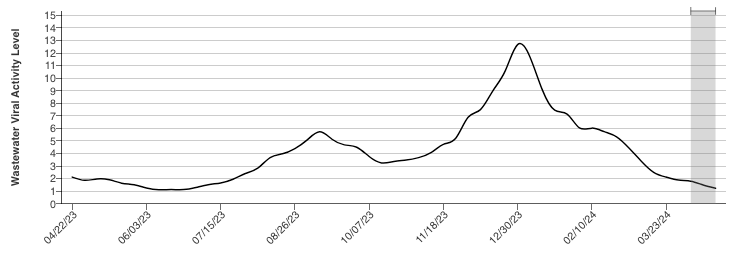A Covid-19 update
More data is sunsetting, new low in hospitalizations (!), and the upcoming fall vaccine formula.
It’s been a while since a Covid-19 update. Some major developments are coming down the pipeline. Here is an attempt to keep you updated, even if it’s not making headlines.
Hospitalization reporting is sunsetting.
During the Covid-19 emergency, the U.S. scrambled to get a national view of severe disease quickly due to our fragmented healthcare system. We eventually created a national hospitalization reporting system where hospitals were required to report capacity, Covid-19 hospitalizations, and more.
This was an enormous step because it led to visibility and, thus, action. This system could be used for many things today and in the future (cough, cough, H5N1). Preparedness is the name of the game; we cannot slip back into the cycle of panic and neglect.
Unfortunately, this hospital reporting requirement is sunsetting today (April 30). Sunsetting means a few things:
Hospitals will voluntarily send data. Given that hospitals hated sending Covid-19 hospitalization data in the first place, I assume that many will stop.
We will rely heavily on our older system, which is suboptimal. In pre-pandemic times CDC created a hospital surveillance system called RESP-NET for flu and other diseases. This system is great but only collects data from about 10% of hospitals, mostly from urban areas. So, this data shows an incomplete and sometimes biased picture. Take this winter, for example, where RESP-NET (the older system) showed flu hospitalizations higher than Covid-19; however, this was not the case when looking at data from the newer, more complete reporting system.
HHS is not giving up the fight. In a welcome development, the Department of Health and Human Services (HHS) has proposed a new rule requiring hospitals to report data outside of an emergency. The new rule’s proposed start date of October 1.
HHS is asking for public comment starting May 2, particularly whether you think this new rule is important. (My humble opinon: It’s an essential system that will protect the health and safety of our communities.) I’ll alert you once it’s open. Your comments will really make a difference.
Covid-19 is at a new low, with variants on the horizon.
Covid-19 in wastewater is at very low levels at this time, which is a welcome reprieve after this respiratory season. This means the probability that Covid-19 is hanging around at a party or daycare is very low.
With it, hospitalizations are at the lowest point since the beginning of the pandemic. What a beauty to see!
SARS-Cov-2 continues to mutate. The next variant on deck is what scientists call “FLiRT,” shorthand for two mutations on the spike protein. Think of these as the children of JN.1.
Will this cause an infection wave? There are many similarities between FLiRT and JN.1—which took over this winter—so this certainly won’t cause a tsunami and probably not even a wave. Maybe a wavelet, depending on how much immunity our communities have. A smaller summer wave would follow a pattern we’re seeing, where each summer wave gets smaller and smaller over time. (See figure above.)
Many of you are asking whether you should get your spring Covid-19 vaccine. My thoughts are on a previous YLE post here, but basically, if you’re over 65 and high risk (i.e., in a nursing home, or have comorbidities), I would. I would also get this sooner rather than later. You don’t want to get your spring vaccine too late, because a fall vaccine will be coming in a few months. We want these spread apart as much as possible.
WHO recommended a vaccine formula for fall. FDA will decide May 16.
WHO recommended a JN.1 formula for the upcoming fall Covid-19 vaccine. Their spring recommendation (including for flu) is an effort to get the global players (i.e., countries and manufacturers) on the same page.
JN.1 is the most recent Covid-19 variant that spread this past winter. Many scientists (including myself) are disappointed because this means we are following the virus instead of getting ahead of it.
The FDA will decide the U.S. vaccine formula plan on May 16. They will likely follow WHO, especially since Novavax has already tested this formula in anticipation of the fall rollout. Protein-based vaccines need a much longer development runway than mRNA vaccines.
I’ll share Cliff’s notes from the May meeting.
Bottom line
Things should be quiet on the Covid-19 front for now. I hope you get to enjoy those graduations and summer vacations!
Love, YLE
In case you missed it:
“Your Local Epidemiologist (YLE)” is founded and written by Dr. Katelyn Jetelina, M.P.H. Ph.D.—an epidemiologist, wife, and mom of two little girls. During the day, she is a senior scientific consultant to several organizations, including CDC. At night, she writes this newsletter. Her main goal is to “translate” the ever-evolving public health world so that people will be well-equipped to make evidence-based decisions. This newsletter is free, thanks to the generous support of fellow YLE community members. To support this effort, subscribe below:








Thanks for updating on the hospital reporting requirement - please do let us know when comments open so that word can spread.
I’m not in the medical or science field. I’m just a 78 (almost) year old woman who tries to stay fit and gets her vaccines. I think it’s important for hospitals to report the high hospitalizations for Covid and flu. Otherwise, the public will not know how important it is to stay updated on their vaccines.